On New Year’s Eve, a fierce voice echoes through the night.
“Any crying children here? Any lazy ones around?”
Men wearing fearsome demon masks and straw garments make their way from house to house, holding flaming torches that light the frozen paths.
This is Namahage, a unique ritual held every year on the Oga Peninsula in Akita Prefecture.
Recognized as one of Japan’s three major eccentric festivals, it is both terrifying and sacred.
Japan is rich in seasonal traditions, but few are as striking or enigmatic as Namahage.
It has long been considered “the night when the gods visit,” and for the people of Oga, it marks the solemn close of the year.
What Is Namahage?
Namahage is a type of raiho-shin—a visiting deity who takes the form of a demon.
These figures are believed to drive away laziness, ward off misfortune, and bring blessings of health and bountiful harvests.
The origin of the name is linked to the word namomi—blisters caused by sitting too long near the hearth.
Namahage literally means “peeling off the namomi,” symbolizing the act of scolding idleness and urging discipline in the winter months.
This custom resembles ancient oni-harai (demon-exorcising) and tsuina rites, rooted in Chinese tradition and practiced in Japan since antiquity.
During the Heian period, tsuina rituals were performed in the imperial court to drive away demons using arrows and chants—echoes of which remain in today’s Setsubun bean-throwing ceremonies.
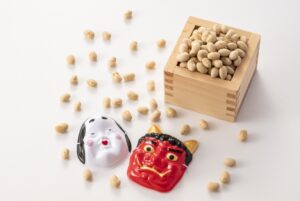
The bean-throwing custom of Setsubun is believed to be a folk adaptation of tsuina, an ancient ritual that evolved over time into its modern form.
Namahage has survived with its original form intact, thanks largely to the environment and lifestyle of Oga.
Located on a remote peninsula jutting into the Sea of Japan, Oga was historically isolated.
This geographic seclusion allowed traditions to remain undisturbed.
In a harsh, snowbound climate where idleness could be life-threatening, Namahage was embraced not just with fear, but with respect.
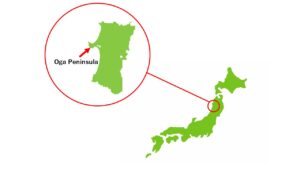
The Oga Peninsula is characterized by its isolated, rugged terrain jutting into the Sea of Japan.
Each village crafted its own masks and costumes, and year after year, Namahage would visit the homes in its region.
This wasn’t performance—it was a cultural practice meant to protect daily life.
Even today, their cries ring out:
“Any crying children here?”
Children still shiver at the sound.
Adults, too, instinctively straighten their backs.
A Night with Namahage
On New Year’s Eve, drums echo through the mountain villages of Oga.
Young men transform into demons, donning masks and straw robes, and walk into the winter darkness with torches in hand.
“Any crying children? Any lazy folk?”
Their voices cut through the frozen air.
Children recoil; adults fall silent.
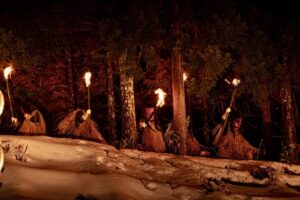
Namahage moving through the night, their torches casting flickering light in the darkness.
Inside each home, the head of the family waits.
When the Namahage enters, he is met with offerings of food and drink.
“We have no lazy ones here,” the host says, bowing his head.
The ritual is more than theater.
In that tense moment, everyone in the room reflects on their own behavior.
When the Namahage finally leaves, a quiet relief settles over the household.
The bad spirits are gone.
The year is ready to begin anew.
There is fear, yes—but also reverence.
And in the ritual, a warmth that ties families together.
The night of Namahage is one of sternness, yet unmistakable care.
The Future of Namahage
Once practiced in every village, Namahage now faces challenges.
Depopulation and aging communities have made its continuation uncertain.
Yet the tradition endures.
In February, the grand Namahage Sedo Festival combines ancient rites with modern celebration, drawing crowds from across Japan and beyond.
In 2018, “Oga’s Namahage” was inscribed as a UNESCO Intangible Cultural Heritage.
The idea of demons visiting homes—not to harm, but to protect—was recognized globally.
Visitors can also experience Namahage firsthand at the Oga Shinzan Folklore Museum, where reenactments and exhibits bring the tradition to life.
Drums, firelight, and that unmistakable voice fill the air.
The spirit of Namahage is very much alive.
To carry this culture forward, the people of Oga continue to adapt.
They don’t simply preserve old forms—they reinterpret the meaning of tradition in today’s world.
Through their hands, Namahage lives on, and its voice will echo into the next generation.
Between Fear and Faith
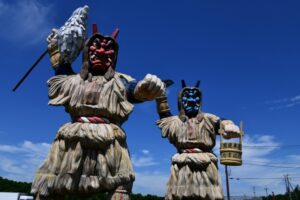
The Giant Namahage Statue in Oga, Akita Prefecture
Namahage is not merely a demon meant to scare.
It rebukes laziness, protects families, and binds villages together.
Its form carries centuries of belief and survival.
When the demon’s shadow looms in the snow, it reminds people of something essential—
To stand tall.
To cherish family.
To quietly prepare the soul for a new year.
As long as that voice is heard, Namahage endures.
It is an ancient ritual, yes—but also a story still unfolding.
And if you ever find yourself in Oga on a winter’s night,
you might just hear it on the wind—
“Any crying children here?”
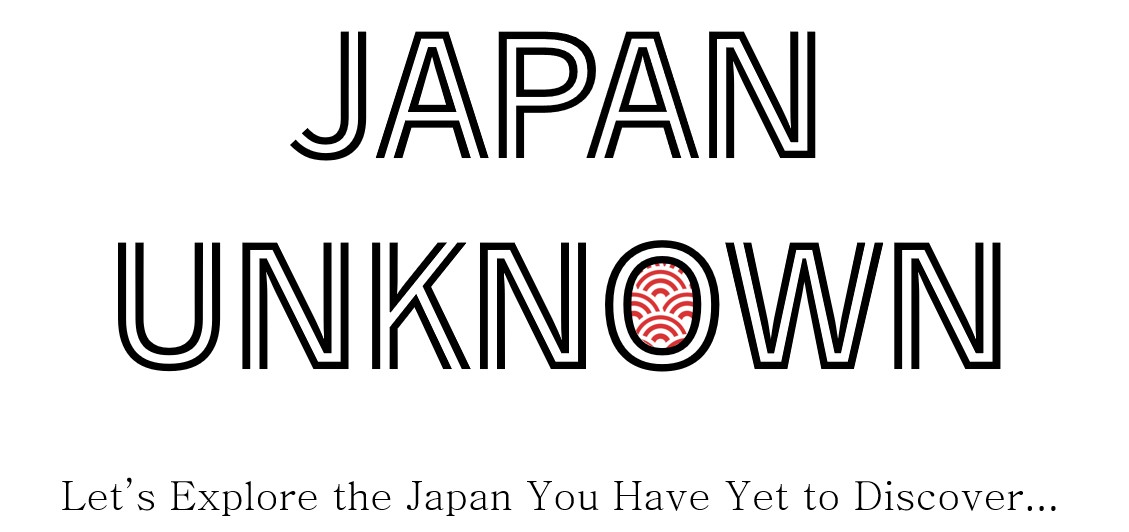
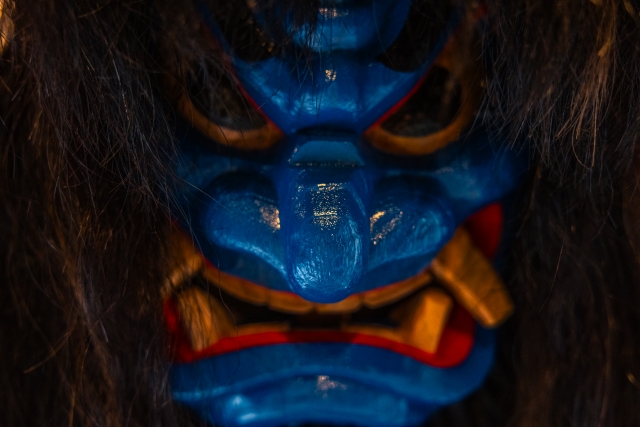


コメント